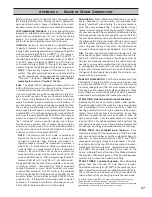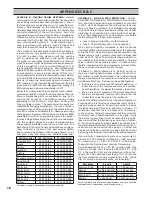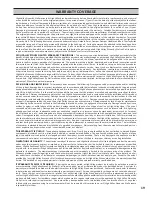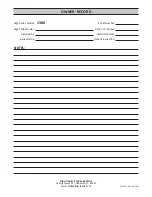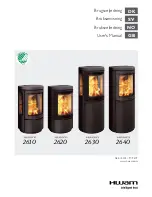
14
K
S
:
During the
fi
rst stage of combus on
keep the Air Damper fully, or nearly fully, open to help
drive o
ff
moisture from the wood load. This stage may
take up to an hour depending on the moisture in the wood.
G V
I
S
:
During the sec-
ond stage of combus on the secondary air tubes at the
top of the
fi
rebox will light o
ff
with a clean fame. Keep
the air damper open enough to support the secondary
burn. The actual opening will depend on the dra of the
individual chimney but a medium to medium-high se ng
is usually op mal.
C
B
:
During the
fi
nal stage of combus-
on the Air Damper opening can be reduced to extend the
burn me. Medium low to medium is op mal. This non-
cataly c wood heater has a manufacturer-set minimum
low burn rate that must not be altered. It is against federal
regula ons to alter this se ng.
C
B
:
To maintain a con nuous
fi
re
fuel must be added while the charcoal bed it hot enough
to kindle the fresh wood. Wear heat resistant gloves when
opera ng and loading the wood heater. Fully open the
Air Damper and then open the Loading Door ½" to 1" to
allow room air balance with the air in the
fi
rebox. Open
the Loading Door slowly to the fully open posi on to
avoid pulling smoke into the room. Have fresh cord wood
logs ready at hand before opening the Loading Door to
minimize the length of me that the door must remain
open. Cord wood should be cut to the appropriate length
or shorter. You should never have to force logs into the
fi
rebox. Avoid contac ng the
fi
rebrick or air tubes when
loading fuel. Close the Loading Door gently, do not slam it
shut. Keep logs from impac ng the Door Glass and never
use the door or Door Glass to push fuel into the
fi
rebox.
Do not operate the wood heater with the door open. If it is
necessary to keep the Loading Door slightly ajar to freshen
the
fi
re, never leave the room while the door is unlatched.
Once loading is complete, reset the Air Damper.
S
O
:
Modern wood heaters can burn wood
very cleanly and e
ffi
ciently but, ul mately, it depends on
the operator to manually adjust the combus on air. The
correct combus on air se ng is dependent on the dra of
the chimney, the fuel being burned, and the stage of com-
bus on. The amount and density of smoke coming from
the chimney is a direct indicator of how the wood heater
is burning. Ideally you will observe li le or no smoke (0%
opacity) if the
fi
re is burning cleanly. Dense smoke indi-
cates poor combus on. Develop a habit of checking the
smoke opacity regularly, and at various stages of combus-
on. With experience a quick glance can con
fi
rm proper
opera on or signal that something needs correc on. Be
aware that in cold weather what looks like smoke could be
moisture vapor condensing in cold air.
O
-
:
Never operate the wood heater in an ex-
treme manner. If any part of the wood heater, the chim-
ney, or the chimney connector glows, you are over-
fi
ring.
A chimney with a very good dra may draw in too much
combus on air, even with the Air Damper in a fully closed
posi on. If the
fi
re seems uncontrollable, consult your
dealer. A hand damper installed in the connector pipe will
allow for manual control under high dra condi ons.
.
CAUTION:
Before ligh ng your wood heater please
read and/or re-read the safety informa on on pages 2, 4,
13, and elsewhere throughout this manual. Ensure that
the wood heater has been installed according to the in-
struc ons given in this manual, to all applicable codes, and
has been inspected as required. Always use safe burning
and opera ng prac ces, and exercise extreme cau on
when fueling and maintaining the wood heater. Wear heat
resistant gloves when opera ng the wood heater. Failure
to follow these precau ons may result in burns or a
fi
re.
L
F
:
Before loading the
fi
rebox with kindling
it is best to test the dra condi ons in the chimney.
• Open the Loading Door carefully.
• Pull the combus on Air Slide damper all the way out so
that it is fully open.
• Crumple one or two pieces of newspaper into a ball,
place them at the back of the
fi
rebox, ignite the paper,
and close the loading door.
• If the smoke from the paper is drawn up the chimney
then proceed with building the
fi
re.
• If smoke has
fi
lled the
fi
rebox but does not seem to
be ven ng, the chimney may be cold. Warming the
chimney may take a few a empts. Open the loading
door very slightly and see if extra air helps.
NEVER
leave the room with the loading door open. Con n-
ued opera on with the door ajar can cause danger-
ous overhea ng of the heater and combus bles.
• In the fall or spring of the year the outside tempera-
ture may not be cold enough to establish adequate
dra . Wait for a cooler day and try again.
NOTE:
In a well insulated home dra may be af-
fected nega vely. In extreme cases dra may be
reversed and cold air pulled down the chimney. Try
opening a window near the wood heater to see if
dra improves. Conversely try turning on a vent
hood or dryer to see if combus on stalls in the
fi
re
box. Introducing outside air, or make-up air, to the
appliance may be the solu on. Consult your dealer.
• Once dra is established, begin to build the
fi
re.
• Build the
fi
re directly on the
fi
rebrick
fl
oor. Never
use
fi
re-dogs, grates, or similar to elevate the
fi
re.
• Tradi onally ghtly twisted sheets of newsprint are
placed at the back of the
fi
rebox with dry so wood
kindling (½ to 1" diameter) on top, followed by
fi
nely
split (1½" to 2") dry wood, and then small logs.
• Using the "top-down" ligh ng technique instead is
highly recommended. Simply invert the pile of kin-
dling. Place the layer of small logs across the
fi
rebox
with the
fi
nely split dry wood arranged on top of the
logs and dry kindling wood as the next layer. Alter-
nate the direc on of each layer of wood and leave
air spaces between the pieces of wood. Use twisted
newsprint or clean burning
fi
restarters to ignite the
kindling. This method has been found to produce
less smoke and emissions during startup.
• Once the
fi
re has fully ignited, open the loading door
slowly and add larger pieces of dry
fi
rewood.
• Control the
fi
re using the combus on air damper.
• Burn dry, seasoned wood, preferably hardwood only.
No other solid or liquid fuels may be used.
O
G

















